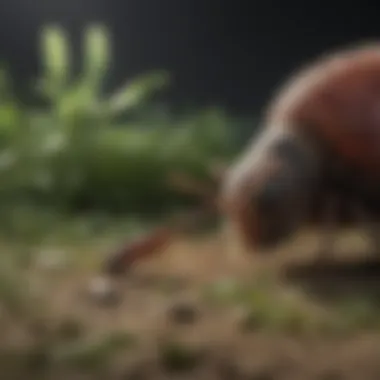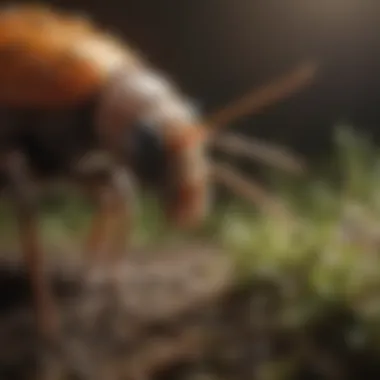Advantages of Integrated Pest Management Explained


Intro
Integrated Pest Management (IPM) stands out as a holistic approach in pest control. It harnesses the power of various strategies to manage pests while minimizing risks to human health and the environment. Traditional pest control methods often rely heavily on chemical usage, leading to short-term relief but long-term consequences for ecosystems and health. By investigating the unique advantages of IPM, we can appreciate how it serves both homeowners and professionals in navigating pest-related challenges effectively.
Pest Identification
Pest identification is the critical first step in any effective pest management strategy. Understanding the specific pests invading your space can significantly influence the success of your control measures. Here are details about some common pests you may encounter:
Detailed descriptions of common pests
- Ants: Small insects that form colonies. They are often found in kitchens or near food sources.
- Termites: Wood-destroying insects that can cause severe structural damage. They are usually found in wooden structures or near decaying wood.
- Rodents: Mice and rats that invade homes in search of food and shelter. Look for droppings, gnaw marks, or nests.
- Cockroaches: Nocturnal insects that thrive in warm, humid environments. Signs include droppings and egg cases, often found in kitchens or bathrooms.
Signs and symptoms of infestations
Identifying an infestation early can save significant costs and headaches later. Common signs include:
- Droppings: Find droppings near food sources; different pests have distinct shapes and sizes.
- Nesting Material: Look for shredded paper, fabric, or plants.
- Chewed Surfaces: Damage to food packaging, wires, or furniture.
- Sounds: Scratching noises during the night may indicate rodents.
Prevention Strategies
Addressing pest issues before they arise is the essence of prevention strategies. These measures can protect your home and reduce reliance on chemical treatments.
Home maintenance tips for pest prevention
- Seal Cracks and Gaps: Inspect your home for any openings and seal them to prevent entry.
- Maintain Cleanliness: Regularly clean areas where food is prepared or consumed.
- Remove Standing Water: Fix leaks and minimize standing water to deter mosquitoes and other pests.
- Proper Storage: Store food in airtight containers to eliminate attractants for pests.
Natural deterrents and barriers
Utilize natural solutions to deter pests without harmful chemicals:
- Essential Oils: Oils such as peppermint or eucalyptus can repel ants and spiders.
- Diatomaceous Earth: This natural powder can be sprinkled in areas where pests frequent, effective against insects with exoskeletons.
- Barriers: Installing door sweeps and window screens can significantly reduce pest entry.
Treatment Options
Incorporating a variety of treatment options enhances the effectiveness of IPM. These can be tailored to specific pest problems, balancing efficacy with safety.
Overview of chemical vs. natural treatments
Chemical Treatments: Often quick and effective, but may pose risks to health and the environment.
Natural Treatments: Focus on low-risk solutions. They generally provide less immediate results but are safer for your home and family.
Step-by-step guides for DIY treatments
- For Ants: Mix equal parts of vinegar and water in a spray bottle. Spray areas where ants are commonly seen. This disrupts their pheromone trails and discourages further activity.
- For Cockroaches: Combine baking soda with sugar and place it in bait stations. The sugar attracts cockroaches, while baking soda kills them.
- For Rodents: Use traps baited with peanut butter in areas frequently visited by rodents. Ensure traps are placed out of reach of pets and children.
By recognizing the unique characteristics of pests, implementing proactive strategies, and employing a diverse array of treatments, homeowners can effectively employ Integrated Pest Management to safeguard their homes. Understanding IPM not only enhances pest control but also promotes a healthier living environment.
Prolusion to Integrated Pest Management
Integrated Pest Management (IPM) represents a paradigm shift in how pest control is approached. Rather than relying solely on chemical solutions, IPM incorporates a variety of strategies that are sustainable and effective. This approach not only aims to eliminate pests but also seeks to minimize potential harm to the environment and human health. Understanding IPM is essential for homeowners who wish to navigate pest problems intelligently and effectively.
The significance of this topic lies in its holistic perspective. By integrating ecological principles with practical pest control measures, IPM offers a framework that is adaptable to specific situations. This makes it particularly relevant for housewives and homeowners alike, who are often looking for solutions that are not only effective but also safe for their families and pets.
As the conversation around environmental sustainability becomes increasingly prevalent, IPM serves as a crucial topic. Many homeowners are investing time and resources into better pest management practices. They seek methods that balance effectiveness with responsible use of chemicals. The modern homeowner's awareness of ecological issues further emphasizes the importance of understanding IPM as a viable alternative to traditional pest control techniques.


In the subsequent sections, we will explore the definition of Integrated Pest Management, delve into its historical context, and outline its core principles. Each of these elements contributes to a comprehensive understanding of IPM's advantages, setting the stage for why it should be the preferred choice in pest management discussions.
Core Principles of Integrated Pest Management
Integrated Pest Management, or IPM, is fundamentally built on several core principles that form the backbone of its strategy. These principles are vital in understanding how to effectively manage pests while minimizing negative impact on the environment and economy. This section will delve into these principles and their relevance in practical pest management applications.
Ecological Considerations
The ecological aspects of IPM are crucial. This method recognizes that pests are part of a complex ecological system. By fostering an understanding of this system, we can make pest management decisions that enhance ecological balance rather than disrupt it. IPM encourages the use of natural predators and parasitic species as a way to control pest populations. For example, introducing ladybugs for aphid control is a common practice in sustainable gardening efforts.
Studies have shown that promoting biodiversity in gardens can reduce pest outbreaks, as a diverse ecosystem is less susceptible to infestations. This consideration not only aids in pest management but also supports the environment, thus reflecting the principle of ecological stewardship.
Economic Viability
IPM's economic viability cannot be ignored. This approach often leads to significant cost savings in the long run. Traditional pest control methods usually rely on heavy chemical usage, which can be expensive and may require repeated applications that further strain a homeowner's budget. Conversely, IPM emphasizes preventive measures and targeted interventions based on monitoring pest levels, allowing for strategic allocation of resources.
Moreover, the reduced dependence on chemical pesticides can lead to lower application costs. Households that adopt IPM can enjoy better financial planning and potentially increase the overall value of their property due to a healthier environment. This principle holds appeal to homeowners who are mindful of both their wallets and their surroundings.
Utilization of Monitoring and Identification
Effective pest management is reliant on accurate monitoring and identification. IPM thrives on the principle that understanding pest populations is essential for making informed decisions. This involves regular inspections to identify pest species and assess population levels.
Utilization of monitoring strategies allows homeowners to act based on data rather than guesswork. For instance, setting up traps can help determine the type of pest infestation, which aids in choosing the most effective control method.
Furthermore, integrating technology in monitoring, such as mobile apps for pest identification, is becoming more common and accessible, providing an efficient way for homeowners to manage their pest challenges. Keeping records of pest observations and control efforts can also improve future pest management strategies.
"Through careful monitoring, homeowners can not only keep pests at bay but also learn about their habits and life cycles, enhancing their overall management skills."
Understanding these core principles is essential for an effective and responsible approach to pest management. By applying ecological considerations, promoting economic viability, and utilizing monitoring techniques, Integrated Pest Management equips homeowners with the knowledge needed to tackle pest issues thoughtfully and effectively.
The Cost-Effectiveness of Integrated Pest Management
The consideration of cost in pest management practices is vital for both homeowners and professionals. Integrated Pest Management (IPM) offers a promising alternative, focusing not only on effectiveness but also on the economic implications. By reducing reliance on chemical treatments and promoting alternative strategies, IPM can lead to significant cost savings in the long run. Addressing pests through a comprehensive approach helps prevent escalated infestations and the subsequent financial burden that may arise from ineffective traditional methods.
Reduction of Chemical Usage
One of the primary financial advantages of IPM is the reduction in chemical usage. By emphasizing monitoring and prevention, rather than routine chemical applications, homeowners can minimize unnecessary expenses. This reduction extends not only to the pest control products themselves but also to their associated application fees. Less frequent pesticide applications directly correlate with lower costs over time. Moreover, sustainable pest management practices lead to decreased risk of pest resistance, which can be costly to manage in the long term.
Using targeted biological controls, such as introducing natural predators, can also reduce the need for synthetic chemicals. Such methods tend to be less expensive and are less harmful to the environment.
Financial Savings Over Time
In terms of overall financial savings, investing in an IPM approach can yield substantial returns.
- Initial Investment: While implementing IPM may require some initial investment in training or monitoring tools, this cost is generally offset by the long-term benefits.
- Avoidance of Major Infestations: Through effective monitoring and early intervention strategies, homeowners can prevent potentially costly infestations. For example, addressing a few insects early may prevent them from becoming a larger issue, which could involve more complex and costly treatment methods.
- Longevity of Solutions: IPM strategies often lead to more sustainable solutions. Many of these methods not only solve the immediate problem but foster long-term pest resistance, further reducing the need for costly interventions.
"The key to maximizing savings with Integrated Pest Management lies in its proactive rather than reactive approach."
Eventually, homeowners may notice a marked difference in their overall expenses related to pest control. By understanding that effective pest management does not solely rely on chemical treatments, but rather a holistic approach, homeowners are better equipped to make informed decisions that lead to beneficial and sustainable outcomes.
Environmental Advantages of Integrated Pest Management
Integrated Pest Management (IPM) stands out as a method that not only addresses pest concerns but also accounts for the environment. This aspect makes IPM especially relevant in today's world, where ecological balance is vital. Understanding the environmental advantages of IPM helps in grasping its role as a forward-thinking approach in pest control strategies. IPM minimizes toxic exposure and supports biodiversity, making it a compelling choice for homeowners and pest management professionals alike.
Minimizing Harmful Chemical Exposure


A primary concern for many homeowners is the impact of chemical pesticides. Traditional methods often rely heavily on these substances, posing risks to household members and pets. IPM emphasizes the reduction of harmful chemical exposure through the use of safer alternatives. By employing a combination of biological controls, cultural practices, and mechanical techniques, IPM provides effective pest management while significantly decreasing the need for potent pesticides.
For example, instead of spraying harsh chemicals, IPM may use insectary plants to attract beneficial insects that prey on pests. This natural method fosters a healthier environment and reduces the toxic burden on the living space. Notably, studies show that households practicing IPM report fewer health issues related to pesticide exposure.
Thus, moving towards IPM not only benefits personal well-being but also contributes to a healthier ecosystem.
Biodiversity Preservation
Biodiversity plays an essential role in maintaining ecological stability. Integrated Pest Management positively influences the preservation of biodiversity, contrasting with conventional pest control that often disrupts the natural balance of ecosystems. By focusing on sustainable practices, IPM encourages the presence of various species, which aids in natural pest control.
One approach involves planting a diversity of crops which promotes a variety of insects. These insects, in turn, can repel unwanted pests, reducing the reliance on chemical treatments. The interconnectedness fostered through these methods also supports pollinators, like bees, which are vital for many plants and agricultural products.
Utilizing IPM thus benefits not just individual properties but contributes to regional biodiversity. In this way, homeowners can take pride in implementing pest management techniques that champion ecological health.
"Integrated Pest Management represents a balanced approach, aiming for harmony between human needs and environmental wellness."
In summary, the environmental advantages of Integrated Pest Management are evident. By minimizing harmful chemical exposure and promoting biodiversity, IPM establishes a more sustainable way to manage pests while caring for the natural world. This is a crucial consideration for today's homeowners who seek effective pest solutions that are also environmentally responsible.
Practical Applications in Residential Settings
The practical applications of Integrated Pest Management (IPM) in residential settings provide homeowners with effective strategies to handle pest issues. Understanding these applications is vital because they empower residents to take control of their living environments in a safe and cost-efficient manner. Implementing IPM principles can lead to a significant reduction in reliance on chemical pesticides, fostering healthier indoor spaces while efficiently managing pest populations.
Tailoring IPM Strategies for Homeowners
Customizing IPM strategies to fit individual home environments can greatly enhance the effectiveness of pest control. Each residential setting presents unique challenges, depending on factors like geography, climate, and the specific pest species involved. Homeowners should start by assessing their own properties for vulnerabilities. This assessment can help determine the best approach to pest prevention.
For example, if a homeowner is dealing with common household pests such as ants or cockroaches, they can adopt several tailored strategies:
- Sanitation Practices: Regular cleaning can eliminate food sources that attract pests.
- Seal Entrances: Identifying and sealing cracks or gaps in walls and windows helps keep pests from entering the home.
- Plant Choices: In gardens, selecting plants that deter certain pests can minimize infestations.
Utilizing local resources, like pest control workshops or community forums, can also help in refining these strategies.
Case Studies: Successful IPM Implementation
Examining real-life examples of IPM in residential settings can illustrate the effectiveness and adaptability of this approach. One notable case involved a suburban neighborhood that faced severe infestations of termites. The residents collectively decided to adopt IPM methodologies.
The strategy included:
- Assessment: A thorough inspection revealed moisture issues as a constant attractant.
- Education: Homeowners learned about preventive measures, such as proper wood storage and moisture control.
- Monitoring: Continuous monitoring allowed for early detection of termite activity, reducing the potential for damage.
As a result, the community saw a decrease in termite populations by over 50% within a year. Such success stories demonstrate that with proper implementation, residential homeowners can effectively manage pests using IPM principles.
Overall, adopting Integrated Pest Management not only minimizes pest-related issues but also promotes environmental consciousness among homeowners. Full comprehension of tailored strategies and learning from successful implementations can yield long-lasting benefits.
Challenges and Limitations of Integrated Pest Management
Integrated Pest Management (IPM) represents a significant step forward in managing pests while considering economic and environmental implications. However, like any approach, it faces multiple challenges and limitations that need careful evaluation and discussion. Understanding these factors is crucial to recognize not only when IPM is most effective but also when it requires adjustment or supplementation with other methods.
Knowledge Gaps and Training Needs
One of the critical challenges in implementing IPM is the lack of knowledge among homeowners and even professionals. Many individuals are not familiar with the principles and practices of IPM. This can lead to improper usage or even a complete avoidance of the strategy altogether. Educational programs and training workshops need to be more widely available to bridge this gap.
For instance, homeowners may need guidance on identifying pests properly and understanding their life cycles, which is essential for implementing IPM effectively. Proper training can empower them to choose the most appropriate management techniques tailored to their specific situations.
Moreover, pest control professionals must also stay updated with the latest IPM strategies. Continuous education will help them provide informed guidance to clients. There is a growing need for certification programs focused on IPM principles and practices that can enhance the skills of those involved in pest management.


"Bridging the knowledge gap can make a significant difference in the success of integrated pest management."
Regulatory and Compliance Issues
Another significant limitation of IPM is the regulatory framework surrounding pest management practices. Local, state, and national regulations can often restrict methods available for pest control. This may hinder the implementation of certain ecological techniques that are fundamental to IPM. Understanding and complying with these regulations requires considerable time and resources, which can deter some from adopting IPM.
Furthermore, some homeowners may not understand the legal obligations related to pest management in their area. Lack of awareness can result in unintended violations of pesticide use laws or other regulations.
To address this limitation, collaboration between regulatory bodies and IPM advocates is essential. Efforts should be made to simplify compliance procedures and provide clear guidelines that can aid homeowners and professionals alike. Simplifying regulations can encourage broader acceptance of IPM practices, ultimately benefiting both the environment and the economy.
Future of Pest Management Practices
As we look towards the future of pest management, it is clear that innovations and technological advancements will play a pivotal role. This is particularly important in the context of integrated pest management (IPM), where the focus is on sustainable practices. The future landscape aims to improve efficiency, effectiveness, and environmental impact, aligning with broader ecological goals.
Advancements in Technology and Innovation
Recent developments in technology are transforming pest control practices. Innovative tools and systems enhance monitoring, identification, and effective intervention strategies. For instance,
- Drones can now survey large areas to identify pest infestations with precision.
- Artificial intelligence is becoming instrumental in processing data from different sources, predicting pest behavior, and providing actionable insights.
Moreover, advancements in biotechnology offer new possibilities. Naturally derived pesticides, such as those made from plant extracts, are gaining traction. These products are designed to target specific pests while minimizing their impact on beneficial insects. This specificity reduces overall chemical use, which is a fundamental tenet of IPM.
Overall, technology enhances the adaptability of pest management strategies, making it easier for homeowners to implement IPM practices in their own environments.
Integration of Smart Solutions
Integrating smart solutions into pest management represents a significant shift. Smart technologies such as Internet of Things (IoT) devices can monitor pest activity in real-time. Homeowners can receive alerts regarding potential infestations, allowing for quicker responses. This level of integration fosters proactive rather than reactive strategies.
Benefits include:
- Reduced pesticide application by targeting specific behaviors.
- Increased awareness of surrounding ecosystems.
As smart technologies continue to develop, their integration into IPM frameworks will likely lead to a new era of pest management.
The combination of technology and smart solutions is set to revolutionize how pest issues are addressed, making pest management not only more efficient but also more sustainable.
As we advance, embracing these changes is essential. Homeowners and pest management professionals alike must adapt to harness the benefits these innovations offer. The future of pest management practices promises not just enhanced effectiveness, but a deeper understanding of ecological balance.
Epilogue
Key benefits of IPM include cost-effectiveness and environmental sustainability. Homeowners adopting IPM often experience lower pest-related costs over time due to reduced dependency on chemical pesticides. This not only saves money but also minimizes risks associated with harmful chemical exposures. More importantly, IPM fosters a balanced ecosystem, allowing for the preservation of beneficial organisms that contribute to overall environmental health.
Additionally, the training and education necessitated by IPM practices encourage homeowners to develop a deeper understanding of pest behavior and effective control measures. As such, adopting IPM leads to more informed decision-making in pest management, creating a safer living space.
Effective pest management is not solely about extermination; it requires thoughtful consideration of ecological and economic factors. Hence, embracing IPM can transform pest control into a more responsible and adaptive practice, aligning with growing concerns about environmental health and sustainability.
Summary of Key Benefits
In this article, we highlighted several key benefits of Integrated Pest Management:
- Cost Efficiency: IPM reduces long-term expenses related to pest management. Less chemical use translates into lower costs.
- Environmental Integrity: Fewer hazardous chemicals contribute to a healthier ecosystem and reduce risks to non-target species.
- Biodiversity: IPM promotes the conservation of beneficial insects, supporting the natural food web.
- Adaptability: Strategies can be tailored to unique pest problems, enhancing effectiveness in diverse settings.
- Educational Growth: IPM encourages homeowners to learn about pest ecology, fostering responsible management practices.
These advantages collectively underscore the importance of incorporating IPM into everyday pest management practices. Being cost-effective, environmentally friendly, and adaptable, IPM stands out as a progressive choice for homeowners.
Encouraging Adoption of Integrated Pest Management
Encouraging the adoption of Integrated Pest Management involves addressing both awareness and understanding. Homeowners need recognition of IPM’s multifaceted benefits. The transition from traditional pest control methods may seem daunting, but this commitment is essential for sustainable living.
To facilitate this change, several steps can be taken:
- Education and Awareness Campaigns: Platforms like Facebook and community forums can be vital in spreading knowledge about IPM principles and practices.
- Workshops and Resources: Local cooperative extensions or agricultural organizations can offer valuable workshops that introduce IPM techniques to homeowners.
- Support Networks: Creating local networks to share experiences and strategies can enhance community involvement and provide practical insights.
- Accessible Resources: Providing detailed guides and easy-to-use materials make the process less overwhelming for individuals unfamiliar with IPM.
"Integrated Pest Management is not just a technique; it’s a philosophy that promotes a healthier home and community."



